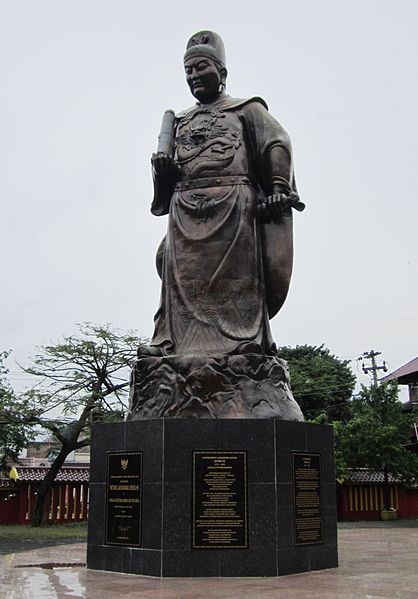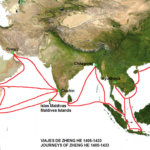Zheng He
Explorer
Age of Discovery
Quick Facts:
Chinese explorer who commanded several treasure fleets – Chinese ships that explored and traded across Asia and Africa. His expeditions greatly expanded China’s trade.
Introduction
Zheng He was a Chinese explorer who lead seven great voyages on behalf of the Chinese emperor. These voyages traveled through the South China Sea, Indian Ocean, Arabian Sea, Red Sea, and along the east coast of Africa. His seven total voyages were diplomatic, military, and trading ventures, and lasted from 1405 – 1433. However, most historians agree their main purpose was to promote the glory of Ming dynasty China.1
Biography
Early Life
Zheng He was born to a noble family in 1371 in the Yunnan Province of China. His father was named Haji Ma, and his mother’s maiden name was “Wen”. Ma He had one older brother, and four sisters.2 His family was Muslim, so when he was born, he was originally named “Ma He.” Ma is the Chinese version of Mohammed, who was the great prophet of the Islamic faith.3 His father and grandfather were highly respected in their community. Young Ma He was educated as a child, often reading books from great scholars such as Confucius and Mencius.4 Ma He was curious about the world from a young age. In Islam, Muslim believers are supposed to make a pilgrimage, called a hajj in Arabic, to the Muslim holy city of Mecca (in present day Saudi Arabia). Ma He’s father and grandfather had both made this hajj, so Ma He often them questions of their journey, along with the people and places they encountered. In 1381, when Ma He was about 11 years old, Yunnan was attacked and conquered by soldiers from the Ming army, who were under the rule of Emperor Hong Wu. Ma He, like many children, were taken captive and brought to serve as a eunuch in the Ming Court.
While serving in the royal court, the Emperor had noticed that Ma He was a hardworking boy. Ma He received military training, and soon became a trusted assistant and adviser to the emperor. He also served as a bodyguard protecting the prince Zhu Di during many battles against the Mongols. Shortly after, Zhu Di became emperor of the Ming Dynasty. Having served in the court for many years, Ma He was eventually promoted to Grand Eunuch. This was the highest rank a eunuch could be promoted to. Because of his new and higher position, the Emperor gave Ma He the new name “Zheng” He.5 With his new title came additional duties Zheng He would be responsible for. He would be in charge of palace construction and repairs, learned more about weapons, and became more knowledgeable in ship construction.6 His understanding of ships would become very important to his future. In 1403, Zhu Di, ordered the construction of the Treasure Fleet – a fleet of trading ships, warships and support vessels. This fleet was to travel across the South China Sea and Indian Ocean areas. The Emperor chose Zheng He to command this fleet. He would be the official ambassador of the imperial court to foreign countries. This would begin Zheng He’s maritime career, and some of the most impressive exploration journeys in history.
Voyages
Principal Voyage
Zheng He’s first voyage (1405-1407) began in July 1405. They set sail from Liujiagan Port in Taicang of Jiangsu Province and headed westward. The fleet had about 208 vessels total, including 62 Treasure Ships, and more than 27,800 crewman.7 They traveled to present day Vietnam. Here, they met with the king and presented him with gifts. The King was pleased with Zheng He and the emperor’s kind gesture, and the visit was a friendly one. After leaving, the fleet traveled to Java, Sumatra; Malacca (the Spice Islands); crossed the Indian Ocean and sailed west to Cochin and Calicut, India. The many stops included trading of spices and other goods, plus visiting royal courts and building relations on behalf of the Chinese emperor. He also saw several new animals, which he told the emperor about upon his return. Zheng He’s first voyage ended when he returned to China in 1407.
Zheng He’s second (1408-1409) and third (1409-1411) voyages followed a similar route to his first. Once again he stopped in places like Java, Sumatra; and visited ports on the coast of Siam (today called Thailand) and the Malay Peninsula.8 Zheng He’s fourth voyage (1413-1415) would be his most impressive yet. The Chinese Emperor really wanted to display the wealth and power China had to offer. With 63 large ships, and a crew of over 27,000 men, Zheng He set sail. Once more he sailed to the Malay Peninsula, to Sri Lanka, and on to Calicut in India. Instead of staying at Calicut as he had on previous voyages, Zheng He and his fleet also sailed to the Maldives and Laccadive Islands to the Hormuz on the Persian Gulf.9 Along the way, they traded goods like silk and spices with rulers of other countries. He returned to Nanjing in 1415. He also brought back with him several envoys or representatives of various countries for the emperor to meet with and learn from.
Subsequent Voyages
By 1417, the Yongle Emperor ordered Zheng He to return the envoys home. Once more back on the seas, Zheng He and his large fleet set sail for his fifth expedition (1417-1419). He stopped in many of the same places, including Java, Sumatra, and also brought letters and riches to the different rulers Zheng He met. On this trip, Zheng He sailed into new waters, to the Somali coast and down to Kenya, both in Africa. He returned back to China in 1419. Zheng He’s sixth voyage (1421-1422) was his shortest of them all. He was authorized to return the remaining envoy’s to their home countries. Not only did he revisit many of the ports he’d been to many times, but also went back to the Mogadishu region of Somalia. He also visited Thailand, before making his way back to China in September 1422. By the time he returned, the emperor had died. The new emperor suspended all expeditions. Zheng He remained in the royal court working for the new emperor, helping with the construction of a large temple. But would be almost another 10 years before Zheng He went on his seventh and final voyage.
Later Years and Death
It was not until 1431 that Zheng He found himself in command of the large Treasure Fleet for his seventh voyage (1431-1433). They sailed to Java, Sumatra and several other Asian ports before arriving in Calicut, India. During this trip, Zheng He temporarily split from the fleet and made his hajj to the Muslim holy city of Mecca.10 At some point, Zheng He fell ill, and died in 1433. It is not known whether or not he made it back to China, or died on his final great voyage.
Legacy
Zheng He’s voyages to western oceans expanded China’s political influence in the world. He was able to expand new, friendly ties with other nations, while developing relations between the east-west trade opportunities. Unfortunately, the official imperial records of his voyages were destroyed. The exact purpose of his voyages, the routes taken, and the size of his fleets are heavily debated because of their unique nature.11 Nonetheless, his leadership and principles have remained known over the centuries in Chinese history. July 11 is celebrated as China’s National Maritime Day commemorating his first voyage.
Images
Endnotes
- Leo Suryadinata, ed., Admiral Zheng He & Southeast China (Pasir Panjang, Singapore: Institute of Southeast Asian Studies, 2005), 44.
- Hum Sin Hoon, Zheng He’s Art of Collaboration: Understanding the Legendary Chinese Admiral from a Management Perspective (Pasir Panjang, Singapore: ISEAS Publishing, 2012), 6.
- Hoon, Zheng He’s Art of Collaboration, 6.
- Hoon, Zheng He’s Art of Collaboration, 7.
- Information Office of the People’s Government of Fujian Province, Zheng He’s Voyages Down the Western Seas (China: China Intercontinental Press, 2005), 8.
- Shih-shan Henry Tsai, The Eunuchs in the Ming Dynasty (Albany: State University of New York Press, 1996), 157.
- Information Office of the People’s Government of Fujian Province, Zheng He’s Voyages Down the Western Seas, 22.
- Brian Fagan, Beyond the Blue Horizon: How the Earliest Mariners Unlocked the Secrets of the Oceans (New York: Bloomsbury Press, 2012), 157.
- Fagan, Beyond the Blue Horizon, 158.
- Fagan, Beyond the Blue Horizon, 162.
- Richard E. Bohlander, ed., World Explorers and Discoverers (New York: MacMillan Publishing Company, 1992), 466.



